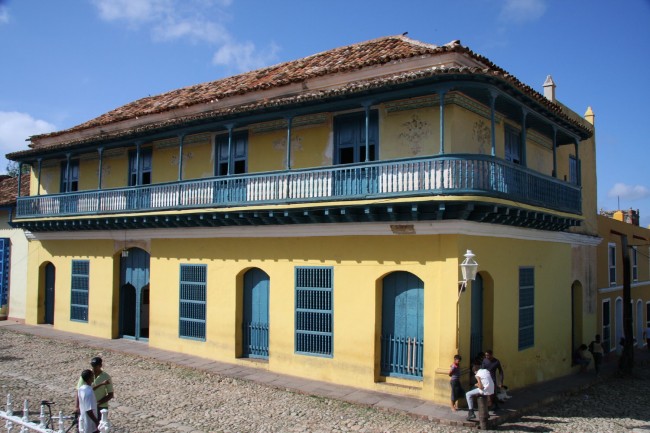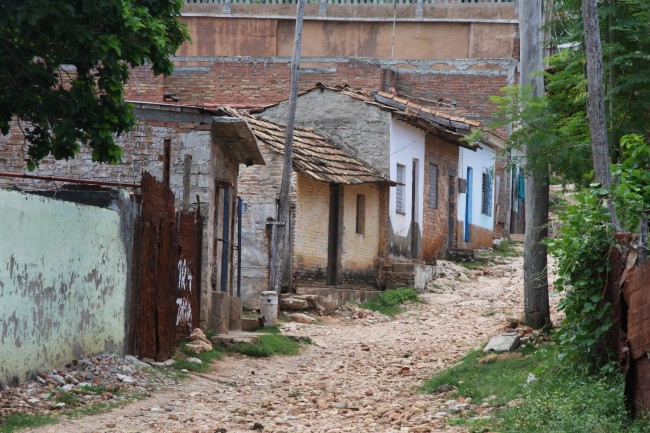The town of Trinidad de Cuba is the jewel of Spanish colonial architecture in Cuba. Founded in 1514, it is the country’s third oldest settlement, and while it once languished in poverty for centuries, Trinidad’s generated wealth from sugar plantations during the 1700s, and expanded dramatically in the early 1800s with the arrival of French planters from Haiti. Fortunes generated on the backs of slaves led to the construction of the exquisite buildings found around the town’s historic square of Plaza Mayor.
So unique is the colonial architecture of the town, with its mix of Moorish, Baroque and Neoclassical styles, that in the 1950s, the Cuban government prohibited all new construction in the area, and in 1988, Trinidad de Cuba was designated as a UNESCO World Heritage site.
Iglesia de la Santisima Trinidad (Holy Trinity Church) was built in 1892 on the foundations of an earlier church. Towering over Plaza Mayor its plain façade stands out amongst the pastel-coloured mansions and casas surrounding the historic square. From the outside it isn’t very impressive but once inside, you are treated to beautiful woodwork and a splendid marble alter.
The restored mansion Palacio Brunet now serves as the Museo Romantico. It is located on the northwest corner of Plaza Mayor. This mansion, first built in 1740, was expanded during the early 1800s. It currently exhibits furnishings from the 1700s displaying the wealth of that era. Palacio Brunet was converted into a museum during 1974 and is one of the two mansions definitely worth visiting.
Museo Nacional de la Lucha Contra Bandidos (National Museum of the Fight Against Bandits), originally built in 1813 as the convent Antiguo Convento de San Francisco de Asis, now displays photographs, maps and equipment used by Fidel Castro’s army to fight against counterrevolutionary forces in the surrounding mountains between 1960 and 1965. If you are into the Cold War and Cuba’s revolutionary history, the displays will be of interest. If you’re less of a history buff, the convent’s beautiful bell tower, a local landmark, is worth climbing to get a view of Trinidad.
Palacio de Aldeman Ortiz, a former mansion from the early 1800s, now houses the Galeria de Arte del Fondo Cubano de Bienes Culturales, which displays locally made crafts and art. It has beautiful pastel blue, hand-turned, wooden grillwork covering its oversized windows. It is a superb example of the transition of Cuban colonial architecture from one- to two-storey buildings in which the ground floor was used for shops and other commercial activities while the second floor housed the family’s living quarters.
On the northeast corner of Plaza Mayor is Casa de la Musica, which exhibits a variety of antique musical instruments. The building adjacent to the museum is Bar Casa de la Musica, which comes to life after 9 p.m. It pulsates throughout the night to salsa rhythms with revellers dancing under the stars until the wee hours of the morning.
Several blocks to the northwest of Museo Romantico is the oldest part of Trinidad. Here you will find traditional single-storey homes in a part of town that has yet to be renovated. These homes represent the converse of the opulence found in Museo Romantico.
Trinidad’s largest mansion, Casa Cantero, now the Museo Historico Municipal (Municipal Museum), is the second of the two mansions worth seeing. Financed through slave trading and sugar plantations, this stunning home is built around a Moorish-style courtyard. The mansion’s high ceilings and perfectly aligned exterior wall windows with the interior courtyard windows keep the building cool during the intensely hot afternoons. The casa’s tower provides a magnificent view of Trinidad and the Caribbean Sea several kilometres to the south.
Casa Padron, now the Museo de Arqueologia y Ciencias Naturales (Museum of Archaeology and Natural Science) houses a collection of flora and fauna along with pre-European archaeological artifacts. If you are into Charles Darwin-related travels, the famous German explorer and scientist Alexander von Humboldt lived here in 1801.

Casa Padron, now the Museo de Arqueologia y Ciencias Naturales
(Museum of Archaeology and Natural Science)
The Museo de Arquitectura Colonial (Museum of Colonial Architecture), formerly the Casa de los Sanchez-Iznaga, was originally two separate buildings with the first home built in 1738 and the second in 1785. They were later joined together in 1819, a technique used fairly frequently to expand Trinidad’s mansions. An interesting display is a re-created 19th-century bathroom showing the early use of steam-powered technology to generate hot water for a shower.

The Museo de Arquitectura Colonial (Museum of Colonial Architecture)
formerly the Casa de los Sanchez-Iznaga
Because it was founded in 1514, Trinidad was not built with car parking in mind. Fortunately, we met Romero, who let us park our rental car in his home’s living room. He also altered the back of his home to accommodate a second car. Romero charges the equivalent of US$1 a night to park your car inside the living quarters of his home. In addition to his parking enterprise he also sells flavourful, strong Cuban coffee and home-cooked fast food from his front door.
Trinidad’s massive wealth was generated on the back of the slave market. A 1774 census shows 1,200 slaves in Trinidad; after the arrival of French planters from Haiti, the number jumps to 12,000 by 1804. By mid-century, the plantations around Trinidad generated almost half of Cuba’s sugar profits. It was this disposable wealth that attracted artists, architects and merchants who went on to build Trinidad’s architectural legacy.
Photo Credits
All photos by Diane Frey – All Rights Reserved
A version of this post was first published at Travel and Escape











Please Share Your Thoughts - Leave A Comment!